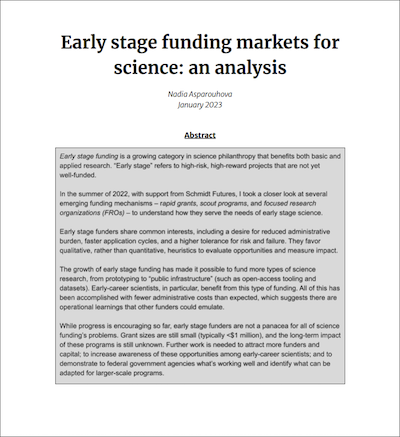Early stage funding markets for science - an analysis
January 23, 2023
In the summer of 2022, with support from Schmidt Futures, I took a closer look at several emerging science funding mechanisms – rapid grants, scout programs, and focused research organizations (FROs) – to understand how they serve the needs of early stage science. I also conducted interviews with funders, program administrators, and grantees to understand their goals, operations, and intended impact, and how their work fits into the existing science funding landscape.
About this report
Changes in science philanthropy in the past decade – a significant growth in capital spend, changing career interests from science and engineering PhD graduates, and increased urgency since the onset of the COVID-19 pandemic – have converged to create the beginnings of a “seed stage” market for science, which addresses a critical funding gap for early stage discovery and prototyping.
Early stage funding is a growing category in science philanthropy that benefits both basic and applied research. “Early stage” refers to high-risk, high-reward projects that are not yet well-funded.
Early stage funders share common interests, including a desire for reduced administrative burden, faster application cycles, and a higher tolerance for risk and failure. They favor qualitative, rather than quantitative, heuristics to evaluate opportunities and measure impact. Funders have also begun to develop new grant vehicles that better suit their needs, including:
- Rapid grants: Grants that are designed for a faster turnaround, usually a few months. Often suited for early stage or proof-of-concept research, or for situations that require an emergency response.
- Scout programs: A method of grantmaking where funds are distributed through a network of scouts, or “regrantors.” Scouts are chosen by the grantmaking organization and are typically well-networked or embedded in the organization’s intended field of impact.
- Focused research organizations (FROs): A special purpose organization that is time-bounded (e.g., 5-10 years) and focused on accomplishing a scientific or technical goal that isn’t adequately addressed by academia or industry – for example, the development of a new platform technology, or publishing a large dataset.
The growth of early stage funding has made it possible to fund more types of research, including proofs-of-concept and prototyping, groundwork for new research fields, interdisciplinary research, and “public infrastructure” for science (such as open-access tooling and datasets). Early-career scientists, in particular, benefit from having more funding available for their work. All of this has been accomplished with fewer administrative costs than is typically required, which suggests there are operational learnings that other funders may want to emulate.
While progress is encouraging so far, early stage funders are not a panacea for all of science funding’s problems. Grant sizes are still small (typically <$1 million), and the long-term impact of these programs is still unknown. Further work is needed to attract more funders and capital; to increase awareness of these opportunities among early-career scientists; and to demonstrate to federal government agencies what’s working well and identify what can be adapted for larger-scale programs.
You can read the full report here.
